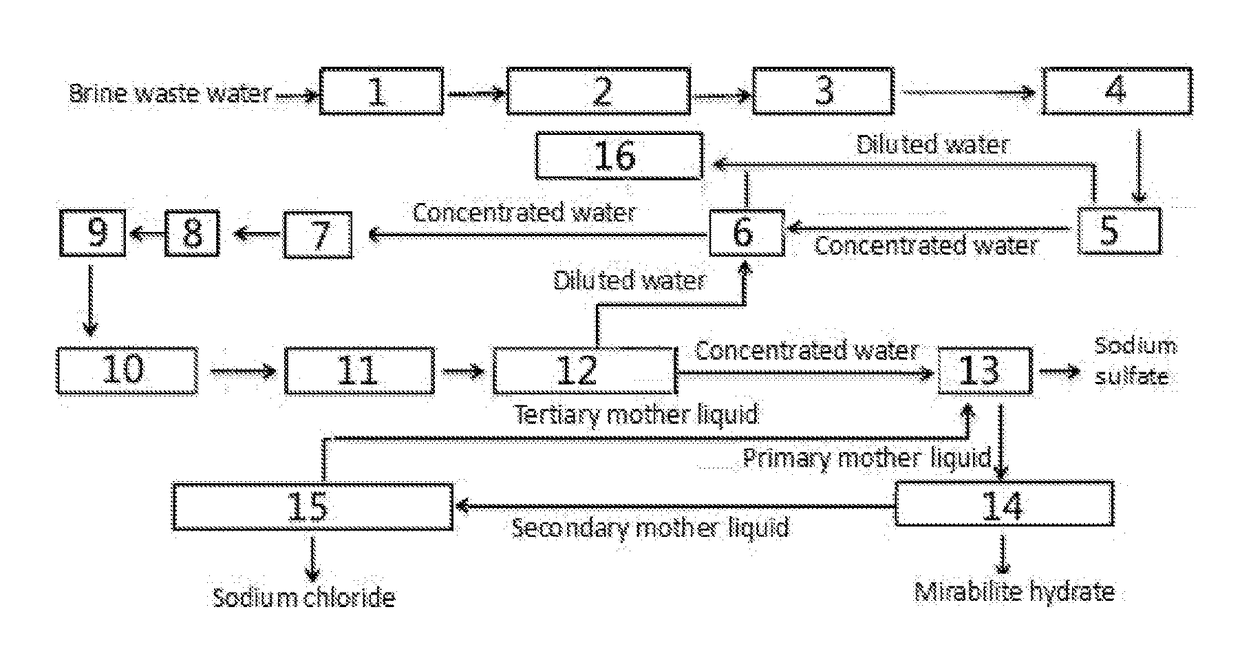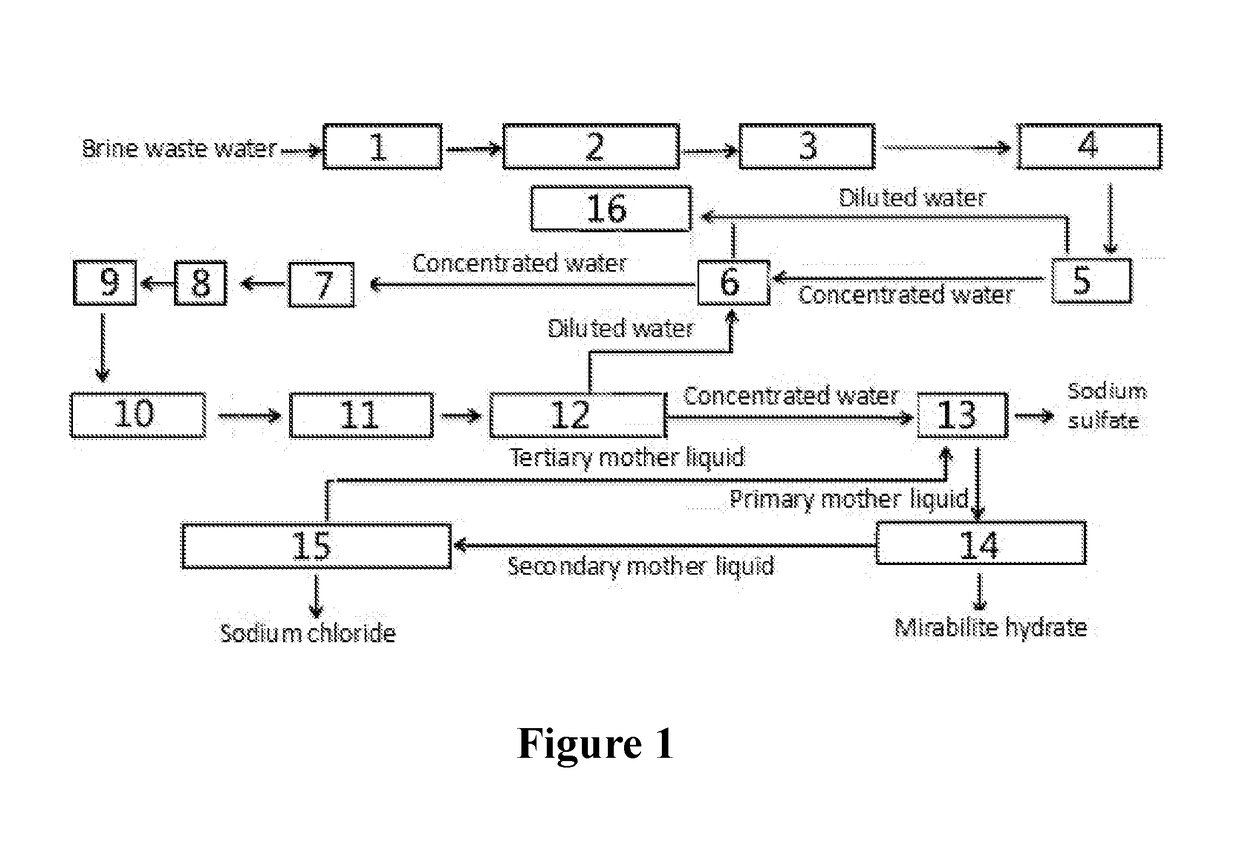Method and System for Treating Brine Waste Water
a technology of brine waste water and treatment method, which is applied in the direction of multi-stage water/sewage treatment, separation process, treatment water nature, etc., can solve the problems of high water consumption of coal chemical projects, large quantity of waste water, and deficiency of water resources and pollutant receiving water bodies, so as to reduce contamination, improve service life and operation stability of membranes, and remove ammonia nitrogen
- Summary
- Abstract
- Description
- Claims
- Application Information
AI Technical Summary
Benefits of technology
Problems solved by technology
Method used
Image
Examples
example 1
[0106]The concentrations of the contaminants in the brine waste water in coal chemical engineering are: COD: 80 mg / L, total hardness (measured in CaCO3): 1,500 mg / L, total alkalinity (measured in CaCO3): 800 mg / L, silicon dioxide: 30 mg / L, TDS: 5,000 mg / L, nitrate nitrogen: 40 mg / L, ammonia nitrogen: 25 mg / L, Cl−: 700 mg / L, SO42−: 1,000 mg / L, and pH is 8. The brine waste water is treated through the process shown in FIG. 1. Specifically, the following steps are used:
[0107](1) The brine waste water is fed into a high-density sedimentation tank 1, calcium hydroxide is added at a ratio of 1.8 g / L into the reaction area in the high-density sedimentation tank 1 according to the quality of the brine waste water to maintain the pH at 10.5-11.0, then sodium carbonate is added at a ratio of 2.0 g / L, PFS coagulant is added at a ratio of 10 mg / L, and PAM coagulant aid is added at a ratio of 1 mg / L; after the brine waste water is coagulated fully in the reaction area, the product is moved to a ...
example 2
[0117]Waste water from the same source as the waste water in the Example 1 is treated through the process shown in FIG. 1. Specifically, the following steps are used:
[0118](1) The brine waste water is fed into a high-density sedimentation tank, calcium hydroxide is added at a ratio of 1.8 g / L into the reaction area in the high-density sedimentation tank according to the quality of the brine waste water to maintain the pH at 11.0-11.5, then sodium carbonate is added at a ratio of 2.5 g / L, PFS coagulant is added at a ratio of 50 mg / L, and PAM coagulant aid is added at a ratio of 5 mg / L; after the brine waste water is coagulated fully in the reaction area, the product is moved to a sedimentation area of the high-density sedimentation tank for sedimentation; finally, sulfuric acid is added at the outlet of the high-density sedimentation tank to adjust the pH to about 7, and a non-oxidizing bactericide (product SMSJ-01D commercialized from SAMMEI company in Guangdong, China) is added to ...
example 3
[0128]The concentrations of the contaminants in the brine waste water produced in an oil refinery are: COD: 100 mg / L, total hardness (measured in CaCO3): 2,500 mg / L, total alkalinity (measured in CaCO3): 1,800 mg / L, silicon dioxide: 10 mg / L, TDS: 6,000 mg / L, nitrate nitrogen concentration is 60 mg / L, ammonia nitrogen concentration is 35 mg / L, chloride ion concentration is 500 mg / L, sulfate ion concentration is 1,500 mg / L, and pH is 8.5. The waste water treatment is carried out through the process shown in FIG. 1. Specifically, the following steps are used:
[0129](1) The brine waste water is fed into a conditioning tank, calcium hydroxide is added at a ratio of 2.8 g / L into the reaction area in the conditioning tank according to the quality of the brine waste water to maintain the pH at 10.5-11.0, then sodium carbonate is added at a ratio of 3.0 g / L, PFS coagulant is added at a ratio of 20 mg / L, and PAM coagulant aid is added at a ratio of 2 mg / L; after the brine waste water is coagul...
PUM
 Login to View More
Login to View More Abstract
Description
Claims
Application Information
 Login to View More
Login to View More - R&D
- Intellectual Property
- Life Sciences
- Materials
- Tech Scout
- Unparalleled Data Quality
- Higher Quality Content
- 60% Fewer Hallucinations
Browse by: Latest US Patents, China's latest patents, Technical Efficacy Thesaurus, Application Domain, Technology Topic, Popular Technical Reports.
© 2025 PatSnap. All rights reserved.Legal|Privacy policy|Modern Slavery Act Transparency Statement|Sitemap|About US| Contact US: help@patsnap.com


